PRINCETON, NJ -- In the 20 states where Hillary Clinton has claimed victory in the 2008 Democratic primary and caucus elections (winning the popular vote), she has led John McCain in ║┌┴¤═° Poll Daily trial heats for the general election over the past two weeks of ║┌┴¤═° Poll Daily tracking by 50% to 43%. In those same states, Barack Obama is about tied with McCain among national registered voters, 45% to 46%.
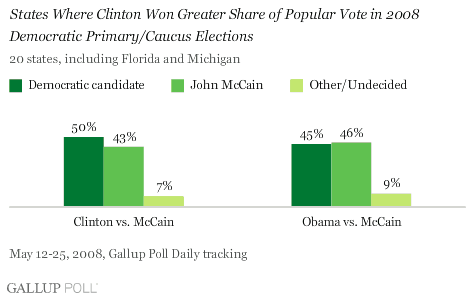
In contrast, in the 28 states and the District of Columbia where Obama has won a higher share of the popular vote against Clinton in the 2008 Democratic primaries and caucuses, there is essentially no difference in how Obama and Clinton each fare against McCain. Both Democrats are statistically tied with him for the fall election.
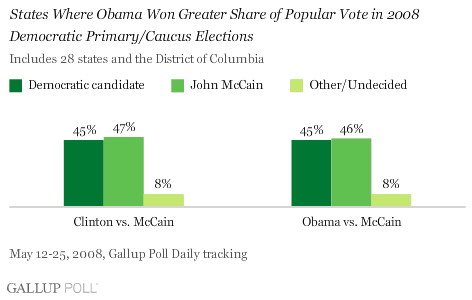
All of this speaks to Sen. Clinton's claim that her primary-state victories over Obama indicate her potential superiority in the general election.
The results are based on aggregated data from ║┌┴¤═° Poll Daily tracking from May 12-25, including interviews with more than 11,000 registered voters nationwide (including Alaska and Hawaii). Across this period, ║┌┴¤═° has found Clinton performing marginally better than Obama in separate trial heats for the general election against McCain. Clinton has led McCain by an average of three percentage points, 48% vs. 45%. Obama has trailed McCain by an average of one point, 45% vs. 46%.
Clinton's popular-vote victories thus far include the three biggest Electoral College prizes: California (a solid Democratic state), New York (another sure bet for the Democrats), and Texas (a solid Republican state). (Although Obama won more delegates in Texas, Clinton's vote total exceeded Obama's by nearly 100,000 votes.) However, her victories also include several of the largest swing states that both parties will be battling to win in November: Pennsylvania and Ohio, as well as wins in the disputed Florida and Michigan primaries. As a result, Clinton's 20 states represent more than 300 Electoral College votes while Obama's 28 states and the District of Columbia represent only 224 Electoral College votes.
(Note that the findings with Michigan and Florida data removed are virtually identical to those shown above. Clinton performs five percentage points better than Obama versus McCain in the states she has won (51% vs. 46%), excluding Michigan and Florida; Obama has virtually no advantage over Clinton versus McCain in the states he has won.)
The question is, do Clinton's popular victories over Obama in states that encompass three-fifths of national voters mean Clinton has a better chance than Obama of winning electoral votes this fall? That's the argument she and her campaign have been making, including at a campaign stop in Kentucky 10 days ago (prior to the Kentucky and Oregon primaries), where she was quoted as saying:
"The states I've won total 300 electoral votes. If we had the same rules as the Republicans, I would be the nominee right now. We have different rules, so what we've got to figure out is who can win 270 electoral votes. My opponent has won states totaling 217 electoral votes."
As the ║┌┴¤═° analysis shows, Clinton is currently running ahead of McCain in the 20 states where she has prevailed in the popular vote, while Obama is tied with McCain in those same states. Thus, at this stage in the race (before the general-election campaigns have fully engaged), there is some support for her argument that her primary states indicate she would be stronger than Obama in the general election.
The same cannot be said for Obama in the 28 states and D.C. where he prevailed in the popular vote. As of now, in those states, he is performing no better than Clinton is in general-election trial heats versus McCain. Thus, the principle of greater primary strength translating into greater general-election strength -- while apparently operative for the states Clinton has won -- does not seem to apply at the moment to states Obama has won.
Red States, Blue States, Swing States
The picture described above is somewhat muddied by the fact that the sets of states Clinton and Obama have each won include reliably "red" (solid Republican) and "blue" (solid Democratic) states. A relative advantage for either Democratic contender in the primaries in such states won't matter come the fall, under the assumption that the general-election outcome in these states is almost a foregone conclusion.
Removing red and blue states from the analysis leaves just the swing or "purple" states that could be competitive for both parties. ║┌┴¤═° defines these as states that favored neither George W. Bush nor John Kerry in the 2004 presidential election by more than five percentage points. Additionally, Arkansas -- one of Clinton's home states -- is considered a potential swing state should she become the nominee. And Missouri is considered swing because although Bush beat Kerry in that state by seven points in 2004, Missouri has switched sides in the three most recent national elections, voting Democratic in 1996, and Republican in 2000 and 2004. (Other states have also switched sides in the last three elections, but the 2004 vote margins in these were well beyond 10 points for either Bush or Kerry.)
Clinton's 2008 swing-state victories include Nevada, Pennsylvania, Ohio, New Hampshire, New Mexico, Arkansas, and -- based solely on popular vote (not delegates) -- Florida and Michigan (her swing states total 105 electoral votes). Thus far in May, ║┌┴¤═° has found Clinton leading McCain in these states by six percentage points, 49% to 43%. McCain holds the slight edge over Obama in these states, 46% to 43%. Thus, as of today, Clinton is clearly the stronger Democratic candidate in this cluster of states where she beat Obama in the popular vote.
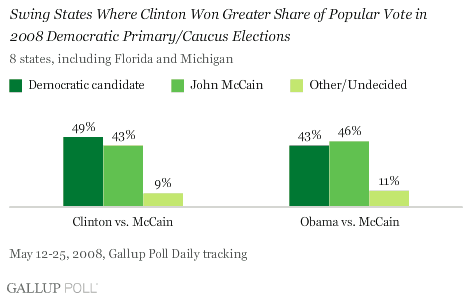
With Florida and Michigan removed from the group of purple states where Clinton has won the popular vote, her relative advantage over Obama expands slightly. (This leaves Arkansas, Nevada, Pennsylvania, Ohio, New Hampshire, and New Mexico, totaling 61 electoral votes.) Clinton beats McCain in this group of states by 10 percentage points, 51% to 41%, whereas McCain leads Obama by three points, 46% to 43%.
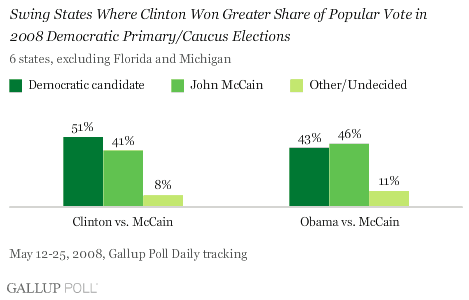
Obama's swing-state victories include Colorado, Oregon, Minnesota, Iowa, Wisconsin, and Missouri (totaling 54 electoral votes). Obama leads McCain in these states by eight percentage points, while Clinton falls one point behind McCain -- a pattern similar to that in Clinton's swing states.
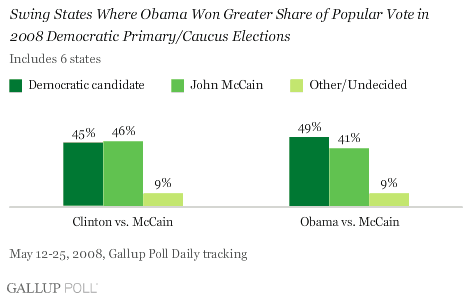
The only other difference seen in the two candidates' general-election performances is in the seven safe (and mostly Southern) Republican states won by Clinton in the primaries. Clinton loses to McCain by four points in these states, while Obama loses to McCain by 14 points. The two candidates fare equally well in the red states Obama won, as well as in the blue states each candidate won. Of course, as noted, relative advantages in the blue states are less important to the presidential election, assuming the outcome is assured regardless of which Democratic candidate is nominated.
Bottom Line
According to ║┌┴¤═°'s May 12-25 tracking polling, Clinton is running stronger against McCain than is Obama in the 20 states where Clinton can claim popular-vote victory in the Democratic primaries and caucuses. By contrast, Obama runs no better against McCain than does Clinton in the 28 states plus the District of Columbia where he has prevailed. On this basis, Clinton appears to have the stronger chance of capitalizing on her primary strengths in the general election.
However, just focusing on the swing states in Clinton's and Obama's respective win columns, the two are fairly similar. Clinton beats McCain in her purple states (including Florida and Michigan) by 49% to 43%, while Obama slightly trails McCain (43% to 46%) in these states -- a nine-point swing in the gap in Clinton's favor. Conversely, Obama beats McCain in his purple states (49% to 41%), while Clinton trails McCain by one point, 45% to 46%, in the same states -- also a nine-point swing in the gap in Obama's favor.
Clinton's main advantage is that her states -- including Florida and Michigan -- represent nearly twice as many Electoral College votes as Obama's. However, removing Florida and Michigan from the equation, her purple states are about comparable to Obama's in electoral vote size, and thus the two appear more evenly situated.
What gives Clinton an additional boost in national support -- but is not likely to increase her chances of winning Electoral College votes in November -- is her superior performance over Obama in the red states where she has captured the popular vote in the primaries. These include such typically safe Republican states as Oklahoma, Texas, Indiana, and Arizona.
Survey Methods
Results are based on aggregated telephone interviews with 11,491 registered voters, aged 18 and older, conducted May 12-25, 2008, as part of ║┌┴¤═° Poll Daily tracking. For results based on the total sample of registered voters, one can say with 95% confidence that the maximum margin of sampling error is ┬▒1 percentage point.
For results based on the sample of 2,753 registered voters residing in "purple" states in which Hillary Clinton won a majority of the popular vote in the 2008 Democratic primaries and/or caucuses, the maximum margin of sampling error is ┬▒2 percentage points.
For results based on the sample of 1,695 registered voters residing in "purple" states excluding Florida and Michigan in which Hillary Clinton won a majority of the popular vote in the 2008 Democratic primaries and/or caucuses, the maximum margin of sampling error is ┬▒3 percentage points.
For results based on the sample of 1,353 registered voters residing in "purple" states in which Barack Obama won a majority of the popular vote in the 2008 Democratic primaries and/or caucuses, the maximum margin of sampling error is ┬▒3 percentage points.
Interviews are conducted with respondents on land-line telephones (for respondents with a land-line telephone) and cellular phones (for respondents who are cell-phone only).
In addition to sampling error, question wording and practical difficulties in conducting surveys can introduce error or bias into the findings of public opinion polls.
To provide feedback or suggestions about how to improve ║┌┴¤═°.com, please e-mail feedback@gallup.com.
